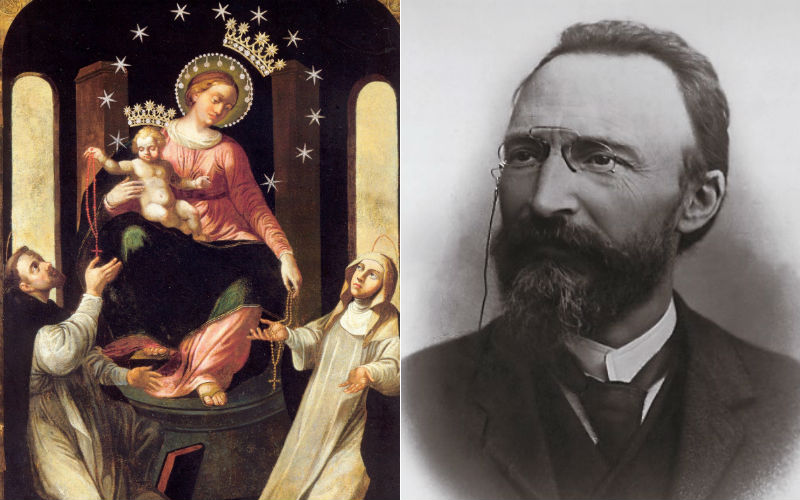This is a Marian Pope. Did he really visit Medjugorje?
We’re not sure we believe that, at this point.
But Marian?
In his address upon ascending to the throne of Peter, Leo XIV said, “Today is the day of the Supplication to Our Lady of Pompeii. Our Blessed Mother Mary always wants to walk with us, be close to us, she always wants to help us with her intercession and her love. So let us pray together for this mission, and for all of the Church and for peace in the world.”
A brief history, this Month of Mary!
In the year 1873, Bartolo Longo—a man once lost in darkness but redeemed through the mercy of Mary; a former spiritualist!—began restoring a dilapidated church in the Valley of Pompeii, a place then filled with poverty and spiritual neglect. Inspired by his growing devotion to the Blessed Virgin Mary and the power of the Rosary, Longo launched a festival in her honor and began sowing the seeds of what would become one of the most beloved Marian sanctuaries in the world.
But it was in 1875 that Heaven offered its most visible sign. Longo acquired a humble and damaged painting of Our Lady of the Rosary from a Dominican convent in Naples. The image—once scorned for its poor condition—depicted the Blessed Virgin handing rosaries to Saint Dominic and Saint Catherine of Siena, symbolizing the spiritual weapon Mary entrusted to the Church. The priest who first purchased the painting paid only eight carlini (less than a dollar), unaware of the treasure he held. When it was entrusted to Longo on November 13, 1875, a new chapter of Grace began.
The image is said to have been miraculously preserved from the destruction of Pompeii by Mount Vesuvius in 79 AD.
Despite its tattered state, the image was placed in the little church on February 13, 1876—the same day Longo founded the Confraternity of the Holy Rosary in Pompeii. Almost immediately, miracles began to pour forth. Healings, conversions, and extraordinary graces were reported by pilgrims who came to kneel before the image. The faithful of the region, though poor, pledged “a penny a month” to help restore the sacred painting and build a fitting home for their heavenly Queen. Three hundred villagers joined that effort, a sign that Mary was stirring hearts from the ground up.
Encouraged by Bishop Giuseppe Formisano of Nola, Bartolo laid the cornerstone for a grander church on May 8, 1876—date now kept as the feast of Our Lady of Pompeii. The church was consecrated in 1891 by Cardinal Raffaele Monaco La Valletta, the personal representative of Pope Leo XIII, who would later author the great prayer to Saint Michael after a vision of spiritual warfare.
Over time, the image underwent professional restoration. The famed artist Federico Madlarelli first attempted to renew it in 1880. A final, reverent restoration by Vatican artists was completed in 1965. That same year, on April 23, Pope Paul VI personally crowned the sacred image, affirming its heavenly origin and powerful intercession.
The shrine’s devotion became inseparable from a special prayer Bartolo Longo himself composed in 1879: the Novena of Petition. He began praying it while ill with typhoid fever and was healed. The novena, which involves praying at least three decades of the Rosary daily for 54 consecutive days, has since become known as the Irresistible Novena. Countless testimonies of healing and spiritual miracles have been attributed to its recitation before the image of Our Lady in Pompeii.
As the number of pilgrims surged, the original church proved too small. In the 1930s, it was expanded into the magnificent basilica seen today—capable of holding up to 6,000 people—while still preserving the sacred Latin cross layout. The 80-meter bell tower, visible for miles, was completed between 1912 and 1925 and remains a testament to faith in stone and marble.
Even in recent times, the love for Our Lady of Pompeii remains strong. On October 19, 2008, Pope Benedict XVI bestowed his sixth Golden Rose upon the shrine—an extraordinary papal honor. And in November 2024, Pope Francis marked the 150th anniversary of the painting’s arrival in Pompeii with a heartfelt letter to the world, calling the faithful to “rediscover the beauty of the Rosary as a tool for peace and evangelization.” His message was carried by Catholic media across the globe.
Today, beneath the majestic Carrara marble statue of the Virgin atop the basilica—inscribed with the word PAX (Peace)—millions continue to journey to Pompeii to kneel before a once-forgotten painting now glorified through grace. It is a living testament to what Heaven can do through the humble Rosary and one man’s radical conversion.
The sanctuary is also the resting place of Blessed Bartolo Longo himself, declared a model for the Equestrian Order of the Holy Sepulchre. His wife and collaborator in faith, Marianna Farnararo De Fusco Longo, also rests there—a quiet witness to the miracle that unfolded in the shadow of Vesuvius.
+




